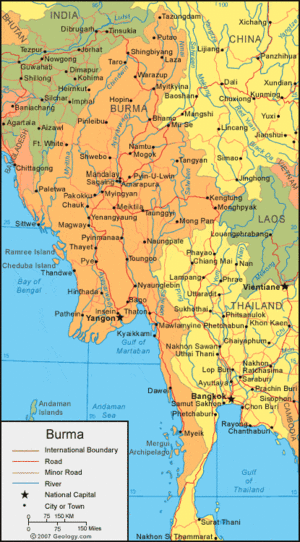Martaban
| Author:Laxman Burdak, IFS (R) |
Martaban (मर्तबान) now called Mottama is a small town in the Thaton district of Mon State, Myanmar. Located on the west bank of the Thanlwin river (Salween), on the opposite side of Mawlamyaing, Mottama was the capital of the Martaban Kingdom (later known as Hanthawaddy Kingdom) from 1287 to 1364, and an entrepôt of international repute until the mid-16th century.
Variants
- Martaban (मर्तबान) (AS, p.750)
- Mottama
- Muttyamandala मुट्टियमंडल, बर्मा, (AS, p.750)
- Burmese: မုတ္တမမြို့, pronounced [moʊʔtəma̰ mjo̰]; Mon: မိုဟ် တၟံ, [mùh mɔˀ]; formerly Martaban)
Origin
"Mottama" derives from the Mon language term "Mumaw" (Mon: မိုဟ် တၟံ; /mùh mɔˀ/), which means "rocky spur."[1][2]
History
Between 2nd-century BCE and 15th-century CE, Martaban was an important trading port in the historic Maritime Silk Road connected the East and West, and Martaban storage jars were imported through this maritime road.
The earliest evidence of the existence of Martaban in Myanmar history was revealed in an inscription erected by King Sithu II of Pagan (Bagan) Empire in 1176.[3]
In the 13th century, Martaban was a southern provincial capital in the Pagan Empire. After Pagan's collapse in 1287, King Wareru founded the Martaban Kingdom based out of Martaban.[4] The city was the capital of a Mon-speaking kingdom from 1287 to 1364. Nominally it was a vassal state of the Thai Sukhothai Kingdom until 1314.[5] From 1369 onwards, the Hanthawaddy kings ruled the kingdom from Bago (Pegu).[6] From 1364 to 1388, Martaban was under the de facto independent rule of Byattaba. In 1388, King Razadarit reconquered the city.[7] Though it was no longer the capital, the city remained an important trading port from the 14th century to the early 16th century.[8]
मुट्टियमंडल, बर्मा
मुट्टियमंडल, बर्मा, (AS, p.750): दक्षिण बर्मा में स्थित एक प्राचीन भारतीय उपनिवेश जो वर्तमान मर्तबान के निकट था.[9]
External links
References
- ↑ Shorto, H.L. (1962). Dictionary of Modern Spoken Mon. Oxford University Press.
- ↑ Tun, Than (1988). "Observations on the Translation and Annotation of the Royal Orders Of Burma". Crossroads: An Interdisciplinary Journal of Southeast Asian Studies. 4 (1): 91–99. JSTOR 40860260.
- ↑ Aung-Thwin, Michael (2005). The mists of Rāmañña: The Legend that was Lower Burma (illustrated ed.). Honolulu: University of Hawai'i Press. ISBN 9780824828868.
- ↑ Coedès, George (1968). Walter F. Vella (ed.). The Indianized States of south-east Asia. trans.Susan Brown Cowing. University of Hawaii Press. ISBN 978-0-8248-0368-1.p.205–206
- ↑ Mukherjee, Rila (2011), Pelagic Passageways: The Northern Bay of Bengal Before Colonialism, Primus Books, p. 212
- ↑ Harvey, G. E. (1925). History of Burma: From the Earliest Times to 10 March 1824. London: Frank Cass & Co. Ltd.p.368
- ↑ Jon Ferquest (Spring 2006). "Rajadhirat's Mask of Command: Military Leadership in Burma (c. 1384–1421)". SBBR. 4 (1): 7–8.
- ↑ Myint-U, Thant (2006). The River of Lost Footsteps—Histories of Burma. Farrar, Straus and Giroux. ISBN 978-0-374-16342-6.p.67
- ↑ Aitihasik Sthanavali by Vijayendra Kumar Mathur, p.750
